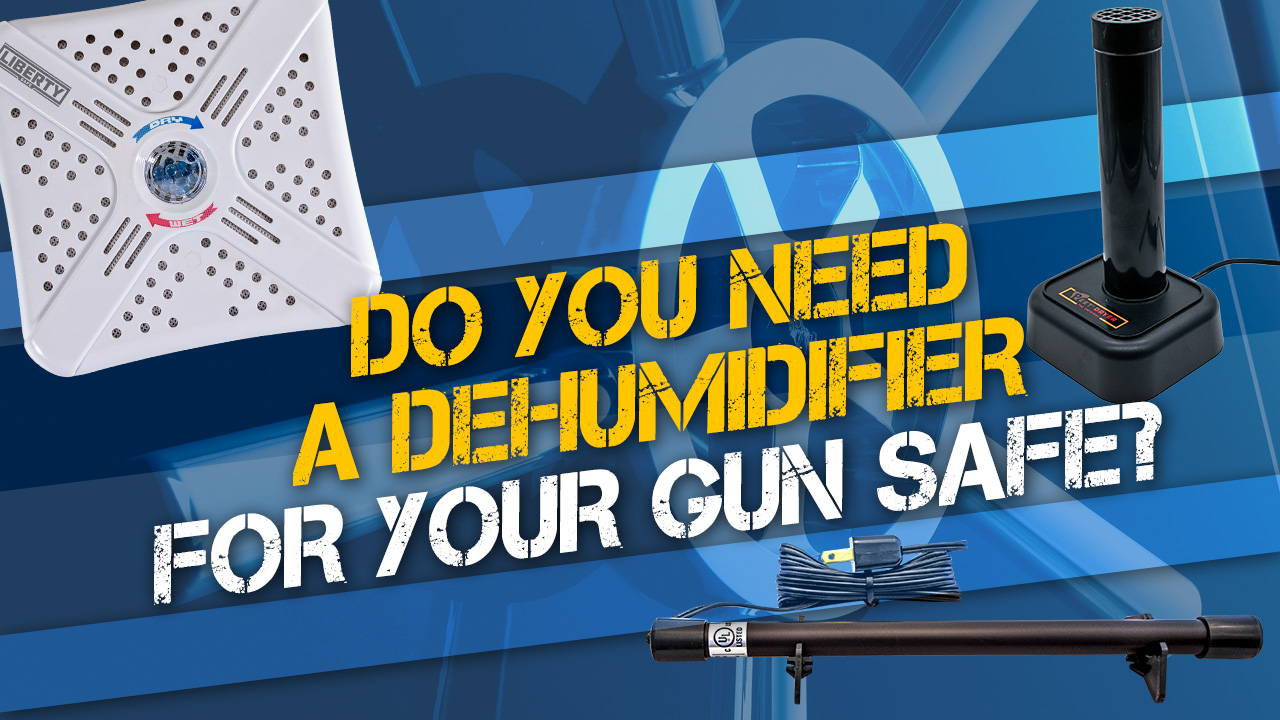When you purchase a gun safe, you may not think of needing an in-safe dehumidifier. However, if the relative humidity in your area is often over 50% (as it is in large portions of North America) and especially if the building in which your safe is located isn’t climate-controlled, an in-safe dehumidifier is not just a good idea—it’s an absolute necessity to prevent corrosion, rust, mildew, and mold on the contents of your safe.
Let’s review the basics of the various methods for keeping your safe inside at the appropriate humidity level for long-term storage of your firearms, valuables, and important documents.
What should the humidity be in a gun safe?
Regarding the ideal humidity and temperature conditions for firearms storage, the NRA recommends keeping the humidity in your vault room or gun safe between 30% and 50% and the temperature around 70 degrees F. If possible, we’d err on the side closer to 30% humidity, as excess moisture in enclosed spaces can accelerate mold growth, rust, and corrosion.
But remember, gun safes aren’t just for storing firearms. There is a long list of things you might not think to store in your gun safe, but you should consider doing so. These include, but are not limited to:
- Family albums and home movies/videos
- Medicines, drugs, pharmaceuticals
- Important personal vital records and legal documents
- Historical and genealogical records, books, journals, photos
- External hard drive backups and other valuable electronics
- And anything else you want to keep safe from loss, fire, or environmental damage
Heat and humidity are bad for the metal and wood of your firearms and wreak havoc on paper, books, photos, leather, electronics, prescription drugs, and almost everything you want to last a long time.
For safely storing documents and photos, librarians and archivists usually specify a temperature-stable environment of between 50 and 70 degrees F (we realize this may not be realistic or even possible inside your home), and the Smithsonian Institution recommends relative humidity levels of between 30% and 50% for paper storage.
So, the humidity in your safe should be kept between 30-50% maximum for the storage of firearms as well as paper documents and other valuables. This can be difficult to achieve in many parts of North America. Even different parts of the same city or rural area can have drastically different humidity levels.
An in-safe dehumidifier is a must if you live in a high-humidity environment. In many cases, a properly humidity-controlled gun or home safe might be the only place in your home that is appropriate for long-term storage of important documents, records, and photos—and of course, firearms.
What is a dehumidifier?
A dehumidifier is a device that removes excess ambient humidity from the air, typically either by heating the air, absorbing moisture from the air using desiccant beads or chemicals, or using refrigerant coils to condense water from the air and collect it in a reservoir to be emptied later. Let’s review the various types, their pros and cons.
Different types of dehumidifiers
When considering what are the best gun safe dehumidifiers for your particular situation, it’s important to understand the different types available. Here are the three primary types of dehumidifiers for gun safes and vaults.
Canister or chemical desiccant dehumidifiers
There are essentially two types of non-electric dehumidifying/moisture-absorbing materials in common usage: Calcium chloride and silica gel desiccants. Products like Damp-rid utilize calcium chloride crystals to absorb moisture from the air and can be useful for drying out enclosed spaces or other areas after a flood. They can be fairly effective, particularly if you replace them regularly. The downside is that as the crystals absorb and then adsorb (hold moisture on their surface) water, they eventually become saturated and dissolve into a liquid brine. The crystals and/or brine must then be disposed of and replaced. In addition, calcium chloride and the resulting brine is corrosive (as anyone who drives on dirt or unpaved aggregate roads treated with calcium chloride knows), so not many people recommend this type of material for use around guns.
Video: How To Store Your Guns (Avoiding Rust and Scratches)
Silica-gel-based dehumidifiers may come in a perforated canister style or may be found in a “cordless” plug-in rechargeable style like the EVA-DRY dehumidifier. Silica gel beads absorb moisture from the air, and these devices work without needing to be plugged in. The EVA-DRY type includes a visual indicator letting you know when the silica beads are saturated and need to be recharged, which means the device is removed from your safe and plugged into an outlet for a few hours to heat the silica beads and drive the absorbed moisture out (or a canister type can be placed in a low oven to remove excess moisture). Then the device can be returned to the safe to continue working at absorbing excess humidity. (Note: You should never leave this type of desiccant dehumidifier plugged in all the time.)
The advantage of the silica gel dehumidifier is it doesn’t require electricity while in use inside your safe, so if you don’t have access to or don’t want to include electrical power in your gun safe, you can still use this type. In addition, this type doesn’t collect standing water or produce any brine when it’s saturated, so corrosion isn’t a concern. It just stops working when the silica gel beads reach their limit, and then they can be renewed with heat. One potential downside of this type is that they only work for so long before they must be renewed. So if you don’t have the ability or desire to check on your safe’s condition fairly frequently, this type is probably not the best choice for you.
Electric dehumidifiers
Plug-in/electric safe dehumidifiers like the Dry Rod Dehumidifier and the PEET Air Circulating Dehumidifier work by heating an element electrically and keeping it at a constant, safe temperature, which creates warm, dry air circulation inside your safe and drives moist air out. For most people, this is the type of in-safe dehumidifier we would recommend, particularly if you already have provision for electrical power to your safe.
This type of dehumidifier circulates slightly warmer air throughout your safe’s interior. As a result, the temperature of the metal parts in firearms is increased slightly (about 3 degrees), which is just enough to eliminate the tendency of cold metal to condense moisture out of damp air. Wood parts are maintained at a temperature that discourages moisture from building up in metal-to-wood contact areas, where they are the most vulnerable to rust and corrosion.
The downside of this type is that it depends on a reliable supply of electricity to function (though the cost is literally pennies per day), so if your safe is in a remote location with questionable power or you don’t have provision for an electrical outlet near your desired safe location, a desiccant-type dehumidifier might be better for you.
Refrigerant/condensation-based room dehumidifiers
For the purposes of use inside a safe, a large-capacity room dehumidifier with a reservoir isn’t necessary or practical. However, this type of refrigerant-based dehumidifier can be a good choice for a vault room if you haven’t made different ventilation and humidity-control arrangements when constructing your vault.
Features to look for in a gun safe dehumidifier
Obviously, any dehumidifier's primary function is effectively removing excess moisture from the air. In practical usage, the indicators on a silica-gel type desiccant dehumidifier should function reliably and any electrical recharging process should be safe and effective. The exterior of the dehumidifier shouldn’t rust or corrode, or get too hot to touch, though rod-type dehumidifiers might get up to 150 degrees F as part of their normal function.
Electrical plugs, wiring, and connections should be safe and durable, and electric dehumidifiers should be UL-listed.
An in-safe dehumidifier shouldn’t take up too much space to be practical while still remaining effective.
Be sure to check the proper function of your dehumidifying system regularly, replace or refresh any desiccant material, and immediately drain any water reservoirs on whole-room dehumidifiers when they reach capacity.
You should also use a hygrometer (humidity gauge) inside your safe or vault to inform you about the moisture content in the air, so you can make adjustments if necessary.
Remember: Not too humid, but not too dry
It’s important not to think of ALL humidity as bad when it comes to storing guns, documents, and valuables. Guns stored in overly dry climates can be damaged, just as they can by being stored in overly humid environments. If it’s drier than about 20% humidity inside your safe, the moisture inside your expensive wood gun stocks can dry out, causing shrinkage, cracking, and damage to the finish.
Humidity below about 20% also can cause desiccation and brittleness in photographs and paper records as well. This is another reason you should invest in a dehumidifier and a digital hygrometer to ensure your safe isn’t too humid or too dry inside.
Pro tip: When storing a lot of wood-stocked firearms in your safe where your ambient air is far too dry, placing a damp sponge in a waterproof bowl or another container in your safe can be a quick and easy way to add some humidity to your safe’s interior if you live in a truly arid locale. Be sure to monitor your safe’s humidity level with a hygrometer, and check the sponge regularly for any mold, replacing it as needed.
Bonus tip: If it’s really humid where you live, avoid storing guns long-term in padded gun cases. The padding can absorb and retain moisture and contribute to rust. Soft gun cases should only be used for transporting firearms to and from a hunt or shooting activity.
Shop our dehumidifiers
Whether you’re looking for a plug-in rod-type safe dehumidifier, an air-circulating dehumidifier, or a silica-gel desiccant-type cordless safe dehumidifier, check out Liberty Safe’s lineup of gun safes and safe accessories.







